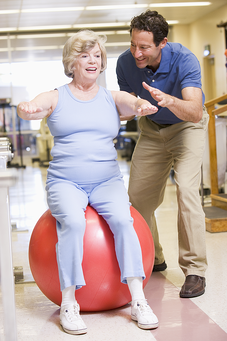 Balance: simple right? I regularly work with a senior population that tells me, “My balance is lost” or “I don’t have balance.” They are under the impression that you either have balance or you don’t.
Balance: simple right? I regularly work with a senior population that tells me, “My balance is lost” or “I don’t have balance.” They are under the impression that you either have balance or you don’t.
But your body’s ability to maintain your balance is much more complicated than having it or not. Your body, or your brain, processes multiple sensory and motor inputs to help you stay upright.
The Sensory Systems Involved in Balance
Your brain relies on sensory information from three systems in your body:
- Vestibular (inner ear): This is a system of channels in your inner ear that allows your brain to know your body’s position, relative to gravity, while your head is moving.
- Vision: This system works with your vestibular system to keep objects in focus by relaying to the brain the location of external objects in relation to the body.
- Somatosensory (nerves): This system is used by the brain to know the position of your center of gravity in relation to your base of support.
Your brain uses the information from your sensory systems with your motor system, which works to control the actions of your muscles to detect changes in your body position with respect to your base.
Balance Diminishes with Age
Your balance naturally diminishes as you age because your brain’s ability to receive and integrate sensory information is reduced. This is why it is important to start training your balance before you begin to notice any problems.
If the function of one or more of your sensory systems declines (say you lose your vision or develop a neurological condition that would affect your somatosensory system), your brain will have to rely more heavily on the other properly functioning systems for information.
What Can I Do to Work on My Balance?
Regular exercise (cardiovascular, strength, and flexibility training) is great for areas of your balance. But if you're looking to focus more specifically on balance, the easiest way is by adding or making simple changes to your current exercise program. You can do this by changing your base of support to make it smaller. The smaller or narrower your base is, the more difficult it is to maintain your balance.
Try adding in exercise stances such as these:
- A narrow stance: Stand with your feet together, side by side.
- Semi-tandem stance: Stand with your feet together and then take a big step forward with one foot. Your feet should be hip width apart with a step length between them.
- Tandem stance: Stand with your feet together and then place one foot in front of the other so you are standing heel to toe.
Other ways to manipulate your base of support include using a BOSU stability trainer, standing on a foam pad or wobble board, or using an exercise ball. These will provide an unstable surface for your base of support, making it even harder. You can also add exercises to the balance stances listed above to challenge your sensory inputs by turning your head side to side or looking up and down, closing your eyes, or reaching with one or both arms.
Balance isn’t just one thing; your brain is constantly working to process all kinds of information to keep you on your feet. But just like any other type of exercise, with some practice you can certainly do a lot to improve your balance.
